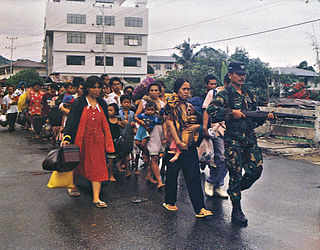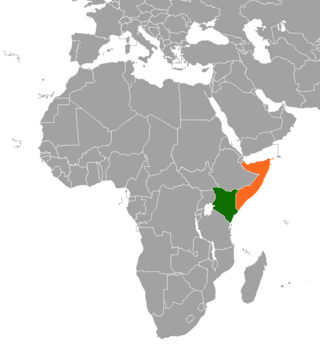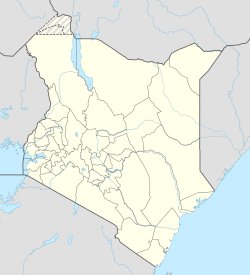Mungiki is a banned ethnic organisation in Kenya. The name means "a united people" or "multitude" in the Kikuyu language. The religion, which apparently originated in the late 1980s, is secretive and bears some similarity to mystery religions. Specifics of their origin and doctrines are unclear. However, the supposed doctrine of Mungiki incorporates elements of traditional Kikuyu customs and values, promoting a return to African spirituality, communal living, and resistance against post-colonial influences.
The Kenya-Turbi City massacre was the killing of fifty-six people by feuding clans in the remote Marsabit District of Northern Kenya on the early morning of 12 July 2005. Hundreds of armed raiders of the Borana tribe attacked the Gabra people living in the Turbi area northwest of Marsabit. Twenty-two of the sixty confirmed dead were children, and over six thousand people fled their homes, most fleeing to Marsabit town. The massacre's aftermath sparked several violent inter-clan conflicts, raising the death toll to ninety-five.

The Loughinisland massacre took place on 18 June 1994 in the small village of Loughinisland, County Down, Northern Ireland. Members of the Ulster Volunteer Force (UVF), a loyalist paramilitary group, burst into a pub with assault rifles and fired on the customers, killing six civilians and wounding five. The pub was targeted because it was frequented mainly by Catholics, and was crowded with people watching the Republic of Ireland play against Italy in the 1994 FIFA World Cup. It is thus sometimes called the "World Cup massacre". The UVF claimed the attack was retaliation for the killing of three UVF members by the Irish National Liberation Army (INLA) two days before.
The following lists events that happened during 2007 in Kenya.
The term taxi war refer to the turf wars fought between taxi associations and individual minibus taxi drivers in South Africa from the late 1980s to the present day.
Major General Mohammed Hussein Ali is a Kenyan military commander. He was formerly commissioner of the Kenya Police. He is currently chief executive of the Postal Corporation of Kenya.
There is a significant crime rate in all regions of Kenya. Petty offences are the most common crime with stealing being the most reported crime. Robbery and theft are among the least cited criminal offences. Crime in Kenya is comparable to Tunisia, with a rate of 3.46 crimes per 100,000 people. However, crime in Kenya often goes unreported and police may lack the training or experience to effectively respond to crimes. Despite the reported low crime rate, Kenya faces significant challenges with organised crime, with many gangs working with corrupt police officers and sometimes even the government. Kenya has a criminality score of 7.02 on the Organised Crime Index, the 16th-most in the world, an improvement from 11th in 2021.
A list of happenings in 2009 in Kenya:

The 2009 Boko Haram uprising was a conflict between Boko Haram, a militant Islamist group, and Nigerian security forces.
The NK Široki Brijeg–FK Sarajevo football riot refers to the riot involving the football clubs NK Široki Brijeg and FK Sarajevo during a leg of the 2009 Bosnian-Herzegovian Premier League in the Herzegovian town of Široki Brijeg. During the riot members of Horde Zla and Škripari confronted each other in altercations which subsequently spilled out to the majority of the town. Horde Zla burned cars and demolished shops while Škripari and residents of Široki Brijeg stoned Horde Zla buses and shot at supporters. Horde Zla also claim multiple counts of severe police brutality which led to the death of Horde Zla member Vedran Puljić from gunshot wounds.
Kagumo is a small town in Kirinyaga County, Kenya.
Kamuiru is a settlement in Kenya's Central Province. Kamuiru is among the most populated places in central Kenya and has a very rich history of the Mau Mau as a concentration camp. This is the place where revolutions began where the villagers led by boda-boda motorists got fed up with the Mungiki at Kagumo, Kirinyaga. Kamuiru is a village situated approximately 500M from Kagumo. During this period, in April 2009, the Vigilantes or Kenda-Kenda Rebellion had a 'Court' christened the Hague.

The May 2010 Lahore attacks, also referred to as the Lahore massacre, occurred on 28 May 2010, in Lahore, Punjab, Pakistan, during Friday prayers. 94 people were killed and more than 120 others were injured in nearly simultaneous attacks against two mosques of the minority Ahmadiyya community. After the initial attack, a hostage situation lasted for hours. Tehrik-i-Taliban Pakistan, as well as their Punjab wing, claimed responsibility for the attacks and were also blamed by the Pakistani Police.

The Maluku sectarian conflict was a period of ethno-political conflict along religious lines that occurred in the Maluku Islands in Indonesia, with particularly serious disturbances on the islands of Ambon and Halmahera. The duration of the conflict is generally dated from the start of the Reformasi era in early 1999 to the signing of the Malino II Accord on 13 February 2002.

The International Criminal Court investigation in Kenya or the situation in the Republic of Kenya was an investigation by the International Criminal Court (ICC) into the responsibility for the 2007–2008 post-election violence in Kenya. The 2007–2008 crisis followed the presidential election that was held on 27 December 2007. The Electoral Commission of Kenya officially declared that the incumbent President Mwai Kibaki was re-elected however supporters of the opposition candidate Raila Odinga accused the government of electoral fraud and rejected the results. A series of protests and demonstrations followed, and fighting—mainly along tribal lines—led to an estimated 1,200 deaths and more than 500,000 people becoming internally displaced.

The Maspero Massacre initially started as demonstrations in October 2011 by a group dominated by Egyptian Copts in reaction to the demolition of a church in Upper Egypt claimed to be built without the appropriate license. The peaceful protesters who intended to stage a sit-in in front of the Maspiro television building were attacked by security forces and the army, resulting in 24 deaths, mostly among the Coptic protestors, and 212 injuries, most of which were sustained by Copts.
On 28 February 2012, approximately 12 militants who were dressed in military uniforms stopped multiple buses on their routes through the Kohistan District in Khyber Pakhtunkhwa, Pakistan. 18 passengers were subsequently taken out of the buses and executed by the militants; 17 of the 18 victims were identified as Shia Muslim residents of Gilgit–Baltistan who were travelling to the city of Gilgit from Rawalpindi, Punjab, while the remaining non-Shia victim was a Sunni Muslim who failed to convince the militants that he was not Shia. The victims were killed on the basis of their religious affiliation with the Shia sect of Islam after identification. Among the dead in the massacre were three children.

The Somali–Kenyan conflict has been an issue within Kenya since the colonial period. Problems have ranged from skirmishes between the two communities and have led to terrorist attacks, police harassment, extortion, home invasions, physical violence, and massacres perpetrated against Somalis and Kenyans.
Between 15 June and 17 June 2014, more than 60 people were killed in attacks in and near Mpeketoni, Kenya. The Somalia-based Al-Shabaab militant group claimed responsibility, but the Kenyan President Uhuru Kenyatta asserted that the attacks were organized by local politicians with ties to a network of gangs. Correspondents from the area suggested that the attacks may have been motivated by ethnic or religious hatred, or revenge for land grabbing.
The 2015 Baga massacre was a series of mass killings carried out by the Boko Haram terrorist group in the north-eastern Nigerian town of Baga and its environs, in the state of Borno, between 3 January and 7 January 2015.







